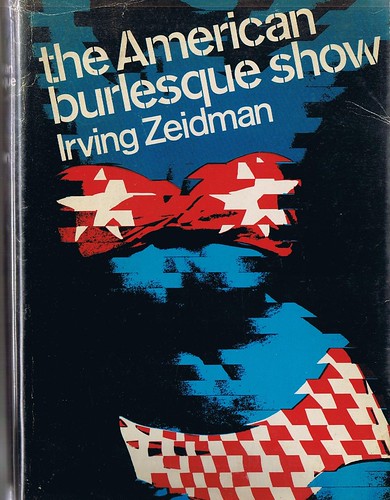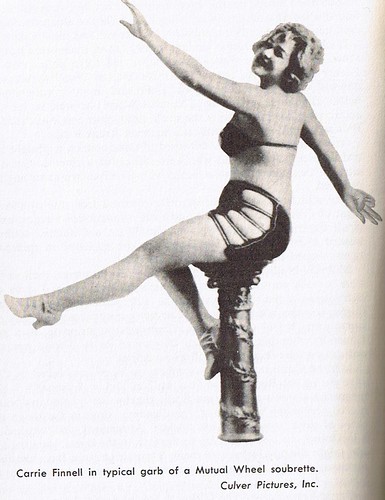Book Review: The American Burlesque Show
The American Burlesque Show
Irving Zeidman
Hawthorne Books, New York, Ny 1967
"The trouble with the American burlesque show, from beginning to end, is either that is has been too dirty--or else that it hasn't been dirty enough."
The first sentence of Irving Zeidman's history of burlesque in the United States (primarily New York) cites a dilemma that continues to haunt burlesque even now, when burlesque is serving in most venues as a couples' or women's alternative to the more commercial, more directly sexual environment of strip clubs (although in New York we have a few venues that are decidedly more hardcore than any burlesque shows of the past--and my story on that is upcoming). Zeidman quotes Sime Silverman saying, "Were there no women in burlesque, how many men would attend?" in 1909. He descibes the history of American burlesque as "the history of its producers' endless efforts to please both the censors and the audience."

This book offers so much detail in less than 250 pages that anyone can count themselves a scholar in a matter of days. It is a seminal reference on American burlesque, and is a significant source in the bibliography of almost every book written about burlesque since its publication. While the history of burlesque is longer than the history of American burlesque, this book is invaluable for those who are primarily interested in the burlesque standard that began with the arrival of British burlesque in the United States in the 19th century. Zeidman describes the path of burlesque from the Black Crook to the Great White Way. He calls the Black Crook "the acknowledged forerunner of modern burlesque because here, for the first time in the history of the American stage, female nudity was exhibited not as an integral part of the plot, but frankly and with bravado for its own crass and pleasant appeal."
If the reader sets Zeidman's commentary aside, the history presented is a story of broad comedians and saucy wenches owning the stage for nearly a century. The arrival of Lydia Thompson and Her Imported British Blondes in 1868 in New York set the standard for shows that mocked politics and popular culture while including women who put themselves shamelessly on display. The shamelessness of the women presented a visual metaphor for the shameless attitude taken in the skits, taunting the pretenses of upstanding citizens and authorities--particularly those who worked to close the burlesque houses down, and succeeded in doing so in New York in 1937 by editing out the strippers.
As with any history, it's hard to know how much of it is biased, but Zeidman's facts are always backed by sources. For all of its thorough documention, it maintains an easy and enjoyable read with plenty of photos, including many of the comics and variety artists as well as of the female dancers he describes as being central to burlesque's appeal. Zeidman has a a dry and companiable tone as he describes the Irving Place Theatre, the Columbia Wheel, the Minksys, and the development of the striptease. He gives details about burlesque in Brooklyn, on the Bowery, in Harlem, and in a chapter titled"Beyond New York" he describes show producers' battles with censors taking the same shape in other cities.

He devotes chapters to the candy butchers, the comics, and of course to the strippers, all with photos to illustrate his quotes from the entertainment media of the eras. He also includes photos of the theatres and neighborhoods.
The history of burlesque via secondary sources can be hard to verify, since so much of the material offered by the burlesque producers is colored by their desires to promote, and so much of what remained in the news media was the result of publicity stunts and press releases offered by those same producers. However, Zeidman makes the most of this and analyzes all of it with an eye to informing and entertaining the reader while taking every claim burlesque has made about itself with a grain of salt--just as burlesque has historically taken the authorities and moral standards of every era with a grain of salt. He studies an irreverent art form irreverently, which is as it should be.
Zeidman says, "Burlesque, unfortunately, has never been any of the fancy or sentimental things ascribed to it--neither now nor then. It has never been a lusty form of folk expression or a national forum for satire or a showplace for knockabout hilarious slapstick. If burlesque ever became too talented, it ceased to be burlesque. It became vaudeville or musical comedy and even...light opera." He often seems to have a quite low opinion of burlesque, albeit with affection for its shortcomings. He never admits how he came to be interested enough in burlesque to do the enormous amount of research labor this book represents. I wonder what he would make of burlesque as it is today.
Out of Print. Available Used.
Irving Zeidman
Hawthorne Books, New York, Ny 1967
"The trouble with the American burlesque show, from beginning to end, is either that is has been too dirty--or else that it hasn't been dirty enough."
The first sentence of Irving Zeidman's history of burlesque in the United States (primarily New York) cites a dilemma that continues to haunt burlesque even now, when burlesque is serving in most venues as a couples' or women's alternative to the more commercial, more directly sexual environment of strip clubs (although in New York we have a few venues that are decidedly more hardcore than any burlesque shows of the past--and my story on that is upcoming). Zeidman quotes Sime Silverman saying, "Were there no women in burlesque, how many men would attend?" in 1909. He descibes the history of American burlesque as "the history of its producers' endless efforts to please both the censors and the audience."

This book offers so much detail in less than 250 pages that anyone can count themselves a scholar in a matter of days. It is a seminal reference on American burlesque, and is a significant source in the bibliography of almost every book written about burlesque since its publication. While the history of burlesque is longer than the history of American burlesque, this book is invaluable for those who are primarily interested in the burlesque standard that began with the arrival of British burlesque in the United States in the 19th century. Zeidman describes the path of burlesque from the Black Crook to the Great White Way. He calls the Black Crook "the acknowledged forerunner of modern burlesque because here, for the first time in the history of the American stage, female nudity was exhibited not as an integral part of the plot, but frankly and with bravado for its own crass and pleasant appeal."
If the reader sets Zeidman's commentary aside, the history presented is a story of broad comedians and saucy wenches owning the stage for nearly a century. The arrival of Lydia Thompson and Her Imported British Blondes in 1868 in New York set the standard for shows that mocked politics and popular culture while including women who put themselves shamelessly on display. The shamelessness of the women presented a visual metaphor for the shameless attitude taken in the skits, taunting the pretenses of upstanding citizens and authorities--particularly those who worked to close the burlesque houses down, and succeeded in doing so in New York in 1937 by editing out the strippers.
As with any history, it's hard to know how much of it is biased, but Zeidman's facts are always backed by sources. For all of its thorough documention, it maintains an easy and enjoyable read with plenty of photos, including many of the comics and variety artists as well as of the female dancers he describes as being central to burlesque's appeal. Zeidman has a a dry and companiable tone as he describes the Irving Place Theatre, the Columbia Wheel, the Minksys, and the development of the striptease. He gives details about burlesque in Brooklyn, on the Bowery, in Harlem, and in a chapter titled"Beyond New York" he describes show producers' battles with censors taking the same shape in other cities.

He devotes chapters to the candy butchers, the comics, and of course to the strippers, all with photos to illustrate his quotes from the entertainment media of the eras. He also includes photos of the theatres and neighborhoods.
The history of burlesque via secondary sources can be hard to verify, since so much of the material offered by the burlesque producers is colored by their desires to promote, and so much of what remained in the news media was the result of publicity stunts and press releases offered by those same producers. However, Zeidman makes the most of this and analyzes all of it with an eye to informing and entertaining the reader while taking every claim burlesque has made about itself with a grain of salt--just as burlesque has historically taken the authorities and moral standards of every era with a grain of salt. He studies an irreverent art form irreverently, which is as it should be.
Zeidman says, "Burlesque, unfortunately, has never been any of the fancy or sentimental things ascribed to it--neither now nor then. It has never been a lusty form of folk expression or a national forum for satire or a showplace for knockabout hilarious slapstick. If burlesque ever became too talented, it ceased to be burlesque. It became vaudeville or musical comedy and even...light opera." He often seems to have a quite low opinion of burlesque, albeit with affection for its shortcomings. He never admits how he came to be interested enough in burlesque to do the enormous amount of research labor this book represents. I wonder what he would make of burlesque as it is today.
Out of Print. Available Used.

Comments
*One of my favorite things about the Minsky book is that at the top of each chapter they've written out one of the original comedy bits used by the Minsky shows' comedians!